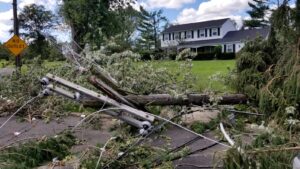A dead truck-sized spacecraft ignited with plasma and pulverized into dust and debris as it tears through the ionosphere and atmosphere. This is what happens to Internet service satellites during reentry. When the full mega-constellation of satellites is deployed in the 2030s, companies will do so every hour because satellite internet requires thousands of satellites to be constantly replaced. And it could compromise our atmosphere or even our magnetosphere.
Space entrepreneurs are betting on disposable satellites as the key to a new means of wealth. There is currently nearly 10,000 active satellites and companies are working as fast as possible to get tens of thousands more into orbit – for a projected 1 m in the next three to four decades.
“We could get to 100,000 satellites within 10 to 15 years,” Dr Jonathan McDowell, of the Harvard-Smithsonian Center for Astrophysics, told me. Those satellites power hyper-connected Internet services and may change some billionaires to trillionaires – at the cost of covering the planet with toxic waste.
The problem is that, contrary to popular belief, space is not really a giant, self-cleaning void. Space keep systems like the magnetosphere that keep us alive and supplied with oxygen by protecting our atmosphere. The space around our planet is a plasma cocoon that cradles life.
It’s easy to assume that the magnetosphere is too large and robust for humanity to ever have any impact on it, but I don’t think that’s true. I am a plasma physicist at the intersection of aeronautics and physics and the author of recent research in peer review that found that the space debris generated by dead and dying commercial satellites could compromise our ionosphere or magnetosphere, also known as our planet’s plasma environment.
After studying the problem for over a year, I have no doubt that the sheer scale of this pollution will somehow disrupt our delicate plasma environment. Yet few people discuss this potential crisis – in part, I suspect because so much scientific research on space is intertwined with commercial space enterpriseswho have a vested interest in avoiding these questions.
When I researched how much dust in the form of satellite and rocket debris the space industry has dumped into the ionosphere during re-entry, I was alarmed to find that it is currently the metal ash of several Eiffel Towers. I wouldn’t have even calculated it without a scientist’s personally managed website. Our ozone is only pennies thick, and soon we’ll put at least an Eiffel Tower’s metal shaft a year directly into the ionosphere. And all this will remain there, indefinitely.
How can we think it’s okay to burn trash in our atmosphere 24/7? Although some study is devoted to stratospheric charging – the phenomenon of satellite and rocket chemicals saturating the atmosphere with ozone depleting alumina – humanity may also impose “magnetospheric charge” on our planet. No one else is currently studying the contamination of the magnetosphere except myself.
We don’t even have a clear estimate of the mass of all regions in the magnetosphere, but we’re going to load it with the wreckage of countless giant spacecraft. These SUV-sized satellites will soon burn up in the atmosphere on an hourly basis. Unlike meteorites, which are small and only contains trace amounts of aluminumare these wrecked spacecraft big and composed entirely of aluminum and other exotic, highly conductive materials. And highly conductive materials can create charging effects and act as a magnetic shield.
If all these conductive materials accumulate in a large layer of debris, they can trap or deflect all or parts of our magnetic field. The Earth is a ball magnet that surrounds us with fast-moving metallic debris. And so far, extrapolating from open source data, the current trash in the ionosphere shows an apparent man-made electrostatic signature. It is known that individual spacecraft can disturb their environment plasma awakens; imagine how 100,000 or more of them and their accompanying trash could disrupt the magnetosphere.
Even if we only cause ionospheric disturbances regionally – say in spaceflight regions – then it can cause holes above the ozone. This in turn may allow atmospheric stripping, which could erode our atmosphere over time and put the planet at risk of losing habitability.
Low Earth orbit is promoted as a “destination and economics” for satellites and even low-gravity space hotels (which seem to be constantly “coming soon” and then cancelled). People like Elon Musk and Jeff Bezos stated repeatedly that space is the key to human longevity. But what if it is the opposite? What if the space industry is the means to our pale blue dot’s demise? And what if all this pollution that space entrepreneurs create happens in such a multidisciplinary, inaccessible, unstudied way that we don’t even understand the risk?
Our magnetosphere keeps us alive. It should be protected as an earth environment. Instead, we fill it with electronic waste so billionaires can trade electromagnetic signals for dollars they really don’t need.
“Our technical civilization poses a real danger to itself,” warned Carl Sagan in his 1997 book Billions and Billions: Thoughts on Life and Death at the Brink of the Millennium. The magnetosphere is our first line of defense against an otherwise deadly solar system, and any pollution thereof must be intensively studied and monitored. Indeed, if an asteroid the size of a Starlink satellite were headed for Earth, it would trigger planetary defense monitoring. But since it’s a man-made object that affects the atmosphere, we don’t monitor it at all.
Space companies should stop launching satellites if they cannot provide studies showing that their pollution will not harm the stratosphere and magnetosphere. Until this pollution is studied further, we all need to reconsider satellite internet.
-
Sierra Solter is a plasma physicist, engineer and inventor who studies the intersection of heliophysics and aeronautics






